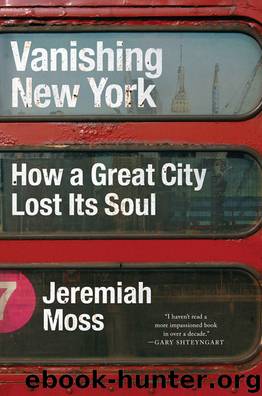Vanishing New York by Jeremiah Moss

Author:Jeremiah Moss
Language: eng
Format: epub
Publisher: HarperCollins
Published: 2017-05-19T04:00:00+00:00
18
THE TROUBLE WITH TOURISTS
Street art by Ivan Orama, with added graffiti, a contemporary take on the classic anti-tourism slogan. Jeremiah Moss, 2014
GROUSING ABOUT TOURISTS HAS LONG BEEN A NEW YORKER’S right and social obligation. Historically, the rube in sandals with a camera around his neck was a mark, someone gullible enough to buy a watch from a thief’s open trench coat or get suckered into a game of three-card monte. In Neil Simon’s 1970 film, The Out-of-Towners, it’s a laugh riot when Jack Lemmon and Sandy Dennis’s suburban Ohio couple goes through the New York wringer of muggings, garbage, and exploding manhole covers. In 1975, cops and firefighters used tourists as cannon fodder in their war with City Hall. When Mayor Beame planned to lay off thousands of officers, their unions took revenge by printing up a harrowing leaflet designed to make New York’s 16 million tourists very nervous. “Welcome to Fear City” featured a grim reaper on the cover and told visitors to stay off the streets after 6 P.M. and “never ride the subway for any reason whatsoever.” There was nothing sacred about tourists. Then the city government remade New York, putting the needs and desires of tourists over residents.
With Milton Glaser’s new “I ♥ New York” logo in hand, Mayor Koch made the seduction of tourists, along with big businesses, an essential strategy in the reconstitution of New York for the globalized age. In her book Branding New York, Miriam Greenberg reveals how, for the first time in history, New York began to fervently market itself in the late 1970s, selling a cleaned-up image for the purpose of commodifying the city for a new clientele of middle-class suburbanites and corporations. To reorient the city after fiscal crisis, as Greenberg explains, “the standpoint of the out-of-towner and the imagination of the average tourist became overwhelming preoccupations for the established and emerging leadership of New York.” Especially when Ronald Reagan pulled federal funds for cities. The resulting rise of mass tourism, like gentrification, was planned. Through a grand campaign, Greenberg says, the city was reframed, packaged, and branded as “one that was almost entirely white, Manhattan-centric, and decidedly not working class.” It was another maneuver in the battle for New York, another advance of the neoliberal shift.
In the early 2000s, after twenty years of popularity, an iconic T-shirt vanished from the streets. “Welcome to New York,” it read. “Now go home.” Its disappearance mirrored the disappearance of a caustic attitude. In Bloomberg’s city it was no longer kosher to complain about tourists. We were told we needed them after 9/11. With the Americanization of New York after the attacks, with Ground Zero turned into a morbid attraction, and with the mayor hyperfocused on increasing tourism, out-of-towners made themselves very comfortable. They began pouring in, slowing down the trains and clogging the sidewalks. Fran Lebowitz had earlier complained, “What a nightmare! No one who isn’t from New York knows how to be a pedestrian. Pedestrians don’t mosey. And they don’t walk five abreast.
Download
This site does not store any files on its server. We only index and link to content provided by other sites. Please contact the content providers to delete copyright contents if any and email us, we'll remove relevant links or contents immediately.
| Anthropology | Archaeology |
| Philosophy | Politics & Government |
| Social Sciences | Sociology |
| Women's Studies |
Nudge - Improving Decisions about Health, Wealth, and Happiness by Thaler Sunstein(6644)
iGen by Jean M. Twenge(4708)
The Fire Next Time by James Baldwin(4352)
Adulting by Kelly Williams Brown(3682)
The Sports Rules Book by Human Kinetics(3597)
The Hacking of the American Mind by Robert H. Lustig(3588)
The Ethical Slut by Janet W. Hardy(3513)
Captivate by Vanessa Van Edwards(3309)
Mummy Knew by Lisa James(3176)
In a Sunburned Country by Bill Bryson(2954)
The Worm at the Core by Sheldon Solomon(2929)
Ants Among Elephants by Sujatha Gidla(2929)
Suicide: A Study in Sociology by Emile Durkheim(2617)
The Slow Fix: Solve Problems, Work Smarter, and Live Better In a World Addicted to Speed by Carl Honore(2579)
Humans of New York by Brandon Stanton(2383)
Handbook of Forensic Sociology and Psychology by Stephen J. Morewitz & Mark L. Goldstein(2380)
Blackwell Companion to Sociology, The by Judith R. Blau(2320)
The Happy Hooker by Xaviera Hollander(2277)
Outliers by Malcolm Gladwell(2263)
